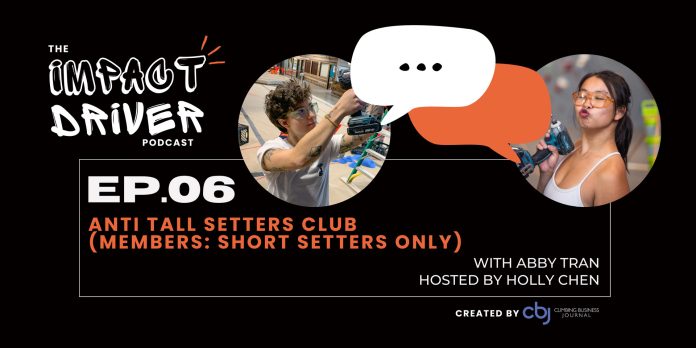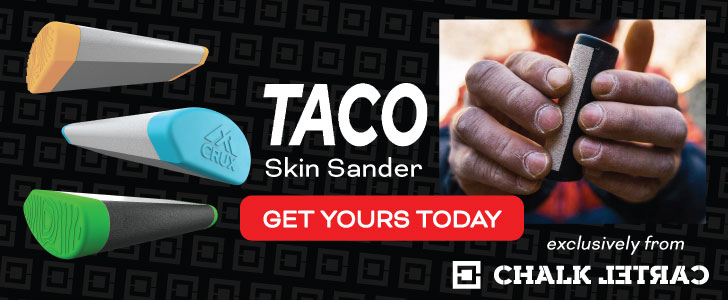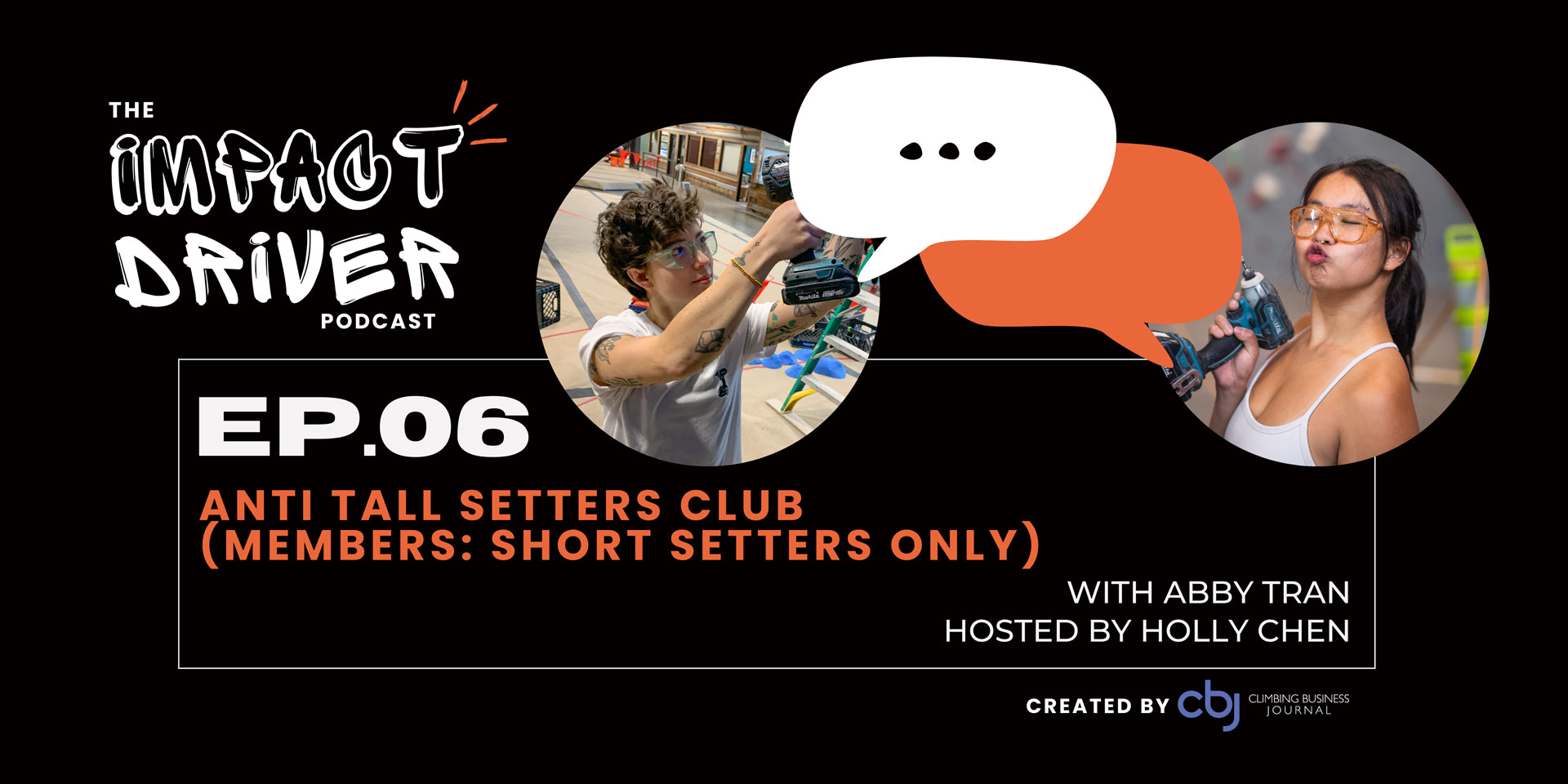
Routesetting as a shorter setter doesn’t come with a shortage of challenges and frustrations. But that’s far from the full story for Abby Tran, Assistant Headsetter at The Circuit Bouldering Gyms in Portland, Oregon. On this episode of the Impact Driver podcast, unabashedly short setters Abby and Holly Chen discuss some of the benefits that shorter people bring to the setting world; the importance of empathy, trust and respect on setting teams; training for setting as a shorter setter and a setter in general; enjoying both aesthetic climbs and a “wrestle” on the wall; avoiding “featherbagging” as well as sandbagging; and at one point, Abby’s cat sneaks onto the show.
Thank you Essential Climbing and Strati Climbing for your support!
And thank you Devin Dabney for your music!
Timestamps
00:00 – Intro
05:09 – How Tran started routesetting
06:20 – Skills that did and did not come easily for Tran
07:54 – Impostor syndrome in routesetting
13:32 – Routesetting as a shorter individual: struggles and tips
24:26 – Supporting team members
33:40 – Advantages of being a shorter routesetter
36:20 – Tran’s climbing and setting styles
40:53 – Grades for a shorter climber
44:49 – Handling negative emotions as a setter
50:05 – Looking forward
51:37 – Closing
Transcript
CHEN: Hey Abby, thanks for joining me tonight. Where are you calling from?
TRAN: Thank you so much for having me, Holly. I’m here in Portland, Oregon.
How is the fall looking like over there? Do you see a lot of cool colors? We only have gold in Colorado, not a whole lot of fancy stuff over here.
Oh, lots of reds and oranges and yellows and lots and lots of green because it is now the rainy season, so the green is popping off over here. It’s gorgeous.
Wow. That’s so cool. Oh, man. I’m making a mental note. I have to visit Oregon in the fall at some point. That sounds really nice. I actually really like the rain.
Well, then this is a perfect place for you. And yes, I highly suggest it because then you can also go see all the waterfalls. Because of all the rain, the waterfalls are also looking real good. So yeah, come on up here. It’s great.
Awesome. I might take you up on that offer someday. Anyway, so I’m really excited to have you on the show tonight because I really wanted to tackle a topic that I think setters would really benefit from, especially setters who may not fall under the widely represented height, so somewhere in like the 5’6 to the 5’10 range. Before we dive into that topic, though, Abby, can you tell me a little bit of how you got started in the setting industry?
Absolutely. I started working as just a desk worker at this tiny little gym in Searcy, Arkansas. And I was watching the setters, you know, do their thing once a week. And I had fallen in love with bouldering, and I was just so enamored by the movement and the art that I just bugged, bugged, bugged the headsetter to let me try out setting, and he finally gave me a chance, and that was a gym where we only had one driver and everybody else used T-wrenches.
I think every setter out there, no matter how new, everyone should set with a T-wrench, at least once. It really teaches you how to avoid elbow tendonitis, for example. Yeah, things like that. Important skills in the setting industry. When you started setting, what were some skills that came really easy for you, and what were some things that did not?
I think the easiest thing that came to me was just the movement itself. I love dancing and moving, and I wanted to incorporate that on the wall. And the flow came pretty naturally. What, however, did not come naturally was simply the construction: Knowing how tight a bolt should be on the wall, what ergonomic hold should feel like, things like that. I was just having kind of a hard time with that at first. Plus, I was setting on walls that were made out of that plaster stuff. It wasn’t, like, plywood or anything. And so learning how to make holes flush and also safe and not spin, I learned how to set in a very kind of rough environment. So that was probably the biggest curve for me, I think, in the beginning.
Well, I think. Well, at least in my opinion, when you can set on those kinds of walls, you can set on every kind of wall. Do you agree?
Oh, yes. After that, it was a breeze.
I think most people, if you’re considering stepping into setting or you’ve just stepped into setting, a lot of people have uncertainties of stepping into a career, like into any other career would. What were some of your uncertainties or fears stepping into this career?
I carry this fear with me always, always have: My biggest fear seems to always be not being good enough. I mean, even now, after having been setting for so long, I tend to have this impostor syndrome, speaking unkind and often untrue words into my head. And being a small female automatically plays into that, of course. I’m always going to have to feel the need to prove myself, my value, my strength and my abilities, in every aspect of the word. And so, yeah, I think coming into a setting position, my fear was, and has always been, “What if nobody likes my climbs? What if my climbs aren’t good? What if I’m just not good enough?”
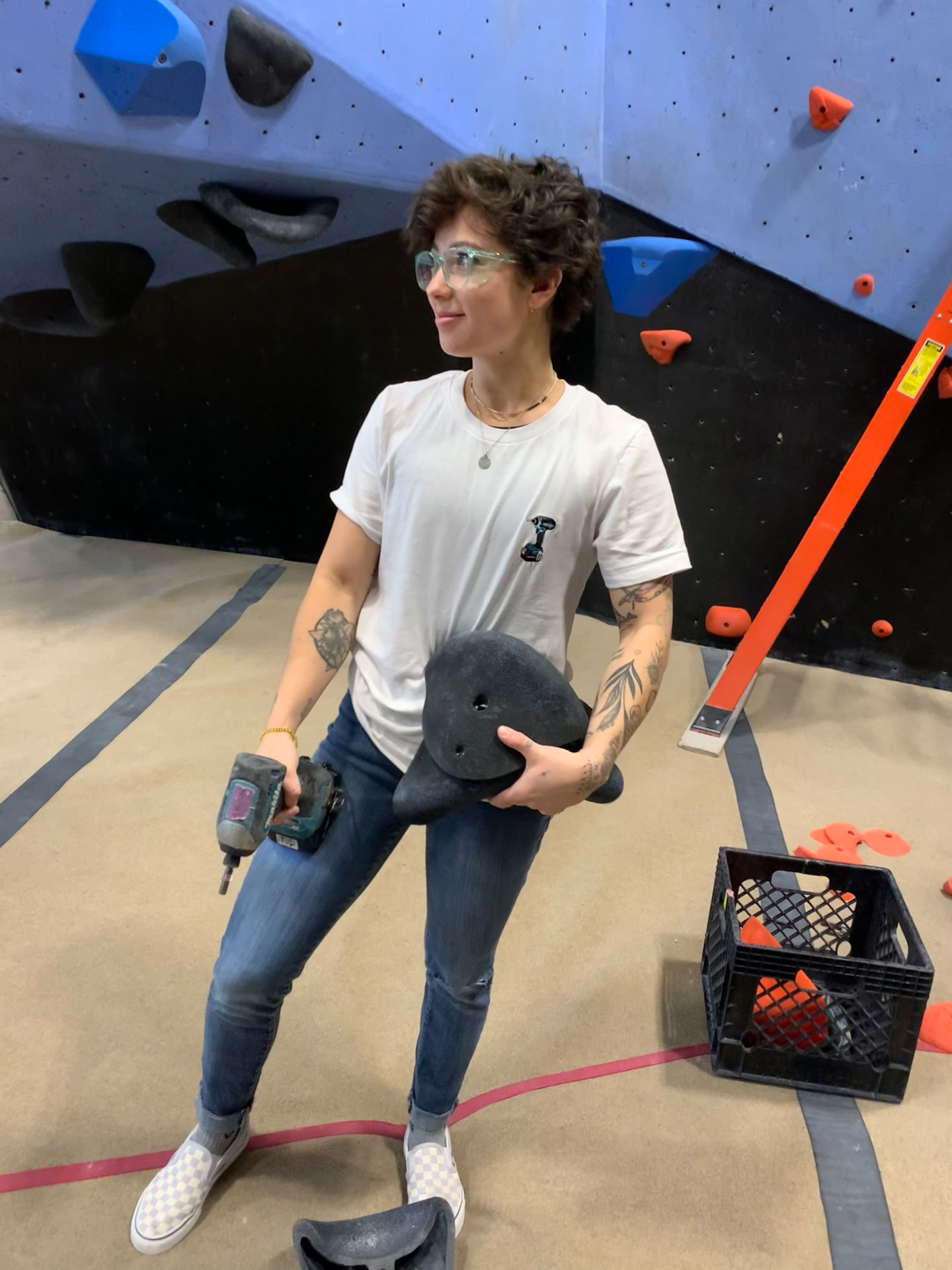
I can empathize with that. I think most setters can empathize with that. What are some techniques that you’ve used or developed over the years to kind of maybe dampen that imposter syndrome or that nagging voice in the back of your head? I personally want to know some of that because I have that, too.
In the beginning, my tactic was simply to learn as much as I could. I told myself, “Well, I can’t look stupid, and I can’t be bad if I know every single thing,” but of course that’s close to impossible to do and pretty naive. But that was my tactic at first. It was to listen to a ton of podcasts, watch a lot of videos, go to as many gyms as possible, talk to as many routesetters as possible. I wanted to be an expert in my field, even though I was far from that. Now, at a healthier stage in my life, I’m still seeking those resources. I’m still watching videos, I’m still listening to podcasts, I’m still talking to other setters. However, my self-talk has become much kinder. I have become much more gentle with myself.
I was told once, which I’m sure this has been said before, but I’ve been told to speak to myself like I’m talking to somebody that I love. And that was actually really helpful, even though it sounds very cheesy. I would never tell even a brand-new setter that she doesn’t belong there. I would never tell an experienced setter that she doesn’t belong here. So why would I tell that to myself? So, lots of intentional practice of my self-talk, I think, has been honestly the biggest help for all of it.
I really like that point. And as cheesy as it might sound, I mean, things are cheesy for a reason. I think they’re cheesy because people resonate with it, because it can be received by a lot of people and it’s good general advice, right? So, are you saying that one of the ways that you try to combat impostor syndrome and negative self-talk is to just continuously be curious and learn?
Yes, I think that is a huge part of it, is to continue doing that research on your own. I have not worked at many gyms that provide professional development. I have often had to go look for that on my own. And because routesetting is becoming more of a sustainable job and career, more of those opportunities are popping up. However, there is still not a ton out there for setters with experience as myself. For example, I don’t really have a ton of interest in pursuing my L’s [USA Climbing Level Certifications]. I think a part of me wants to, because right now that seems to be the only option. Otherwise, there are a lot of setting clinics for newer and intermediate setters, which is awesome and I am so excited about that. But what I am always looking for is more of an educational clinic for seasoned setters who only set in commercial gyms or for local competitions, things like that. You do have to be a little bit more creative in where you look for inspiration and where you get your educational material and things like that. But, yes, always stay curious, always be thirsty to learn more and to become better.
I think a large part of the industry, myself included, share that frustration with you. It’s just, aside from USAC levels—which, really, primarily focus on comp setting—it’s really difficult and it’s easy to be like, “Oh, wow, that move looks amazing, it’s been set at a World Cup…Let’s try to recreate that in my gym.” And I think that’s an amazing way to learn new movement. But at the same time, it is pretty far from what your average commercial gym might need. So, is there no clinic out there to teach me how to take my ability to set a flowy climb from 90% to 99%, right? I really wish that the industry would eventually move in that direction to offer every setter, no matter what level, a way to further their education.
That would be great, and that is what I’m always looking for and hoping for.
So the main topic that I want to tackle with you today, Abby, is nuanced tips for smaller setters. Abby, do you mind sharing with the audience how tall you are and your wingspan?
Yes. My height is at 4’11, and my wingspan is also at 4’11.
So, I want to tell the audience a story. I met Abby a couple of years ago at a setter showdown in Texas. And I remember at that point, I was relatively green. I had only been setting at two gyms, and I didn’t really know the setting community that well. I turned around and saw Abby pick up a heavy-duty, 15-foot A-frame and move it across the gym at breakneck speeds, like it weighed nothing. [laughs] And at that point in my career, I was trying to hide how scared I was of extension ladders. Just, you know, I just pretend that, “Hey, this is just a normal thing. I pick these up.” In reality, I’m thinking, “Oh my God, I’m going to kill somebody.” [laughs] So that was what I thought, “How does she do that?”
And that’s why I want to talk to Abby today, is because there are a lot of setters out there who do not fall into the average height of 5’6 to 5’10 that is what we see in the setting industry. So, I believe that education to help smaller setters make that learning curve more manageable is lacking. I wish I had someone teach me how to pick up an A-frame as a smaller person. I wish someone—oh, by the way, I am 5’2 with an even wingspan, so taller than Abby, but not a giant. [laughs] So, to get into this topic, Abby, what are some routesetting job requirements that may be harder to come by for a smaller person compared to your average size dude?
Yes. First, Holly, I would like to say that my dream height is 5’2. [laughs] You’re a perfect height. I’m a perfect height. It’s all fine.
We’re all perfect.
We’re all perfect. [laughs]
Yes. [laughs]
As you were talking about job requirements, yeah, the first thing that came to my mind was moving ladders and moving volumes.
Absolutely.
I cannot tell you how awkward it is to hold a volume that’s even 4-foot wide. My wingspan is 4’11, but trying to carry a volume that’s almost as tall as me is one of those awkward things. I do it, but it’s not pretty and it’s not fun. And I will often ask for help, and I’m not afraid to ask for help, but I can do it on my own, but it’s not fun. Yeah. Moving ladders is an absolute struggle. I feel like those are two that are pretty difficult for anyone smaller than, I think, 5’5, honestly. It’s just hard things to do. Aside from that, however, the hardest part of my job is pulling my hardest at full extension. I don’t think taller people often understand that sometimes a move for them can feel two grades harder for shorter people. And it’s simply because we are having to generate power from totally extended arms and legs.
So, one of the ways that I’ve trained for this, other than simply having to climb like that most of the time, was climbing on a spray wall, actually. I was able to practice my contact strength, my pull through power, little by little because I could use those intermediate holds to just bump and bump and bump and eventually try to throw and catch to those. I actually now use the campus board to practice my long throws and to practice my bumping. A lot of it is in my shoulders, so a lot of my training has involved shoulder mobility and strength, and that has been, I think, the biggest help for me. And then picking up ladders and volumes and being able to hold them. I do a lot of leg workouts, so those are two biggest things that I helped myself in.
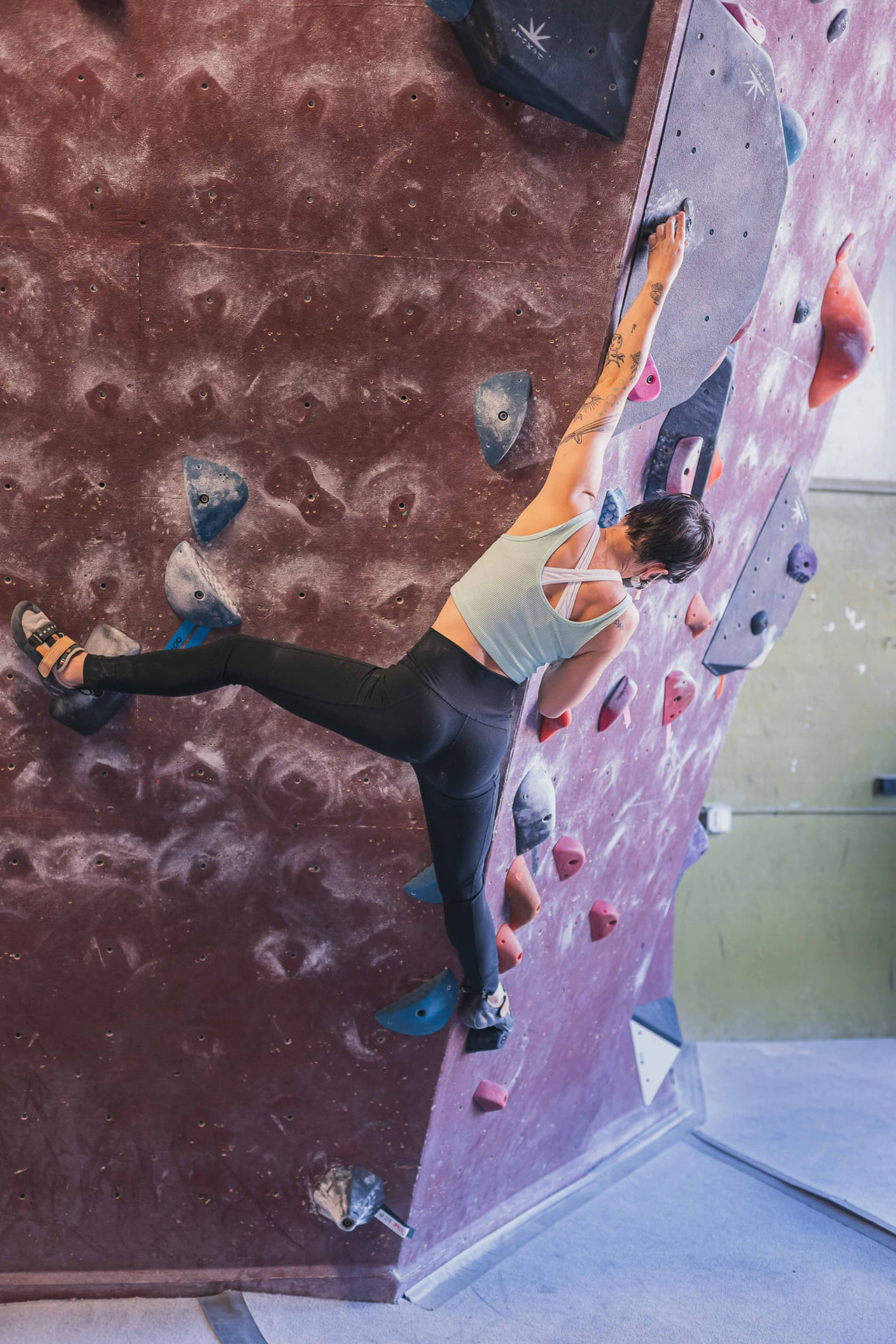
I have not heard of the spray wall idea for short people, and I think I’m going to take that into my own training, as well. Because 5’2 is not short, but yeah, like I said, I’m not a giant either. So I’m definitely sometimes just feeling like, how am I supposed to bend my legs and generate if I’m on tiptoes, right?
Yeah, it is very difficult.
Exactly. And when I put myself in those positions or if I set a powerful or somewhat reachy problem, I’m always thinking, “Okay, there are people shorter than me. There are team kids who are going to be training on this.” And one of my favorite coworkers actually told me, he said, “Ignore boxing tall people out. They can be boxed out every now and then. They can be scrunchie every now and then.” And I took that advice to heart. At least I’m trying. [laughs] So, let’s go back to some of the technical aspects of ladders and volumes. For me, when picking up a big volume, one of my tips is to put a jug, down climb jug, or dirty hold, whatever it is onto the volume, whether it be a bolt or a screw, and then lifting the volume that way. But in terms of ladders, I just eventually got used to it and believed the job made me stronger. However, what tips do you have that can help a setter of our size or smaller kind of fast track that process, in terms of picking up things that are going to mess with your center of gravity, essentially?
Yes. So, yes, adding jugs to volumes is an excellent idea. I think anybody should do it even just to not hurt your tendons or anything on the edges of the volume. I think using jugs is really helpful. As far as the ladders, yeah, you get used to figuring out where the best balance point is. I, for some reason, can only carry it on my right shoulder and not my left, I guess because I’m right dominant, but for some reason it hurts more on my left and I haven’t figured out why. But I found that stabilizing exercises helped with that as well. Practicing standing on one foot, even though you don’t carry a ladder with one foot, practicing how that feels, kind of being off balance and working on core strength. A lot of it just comes down to being able to stabilize yourself with your legs and your core, but it’s getting used to it and you’ll get it after doing it a few times.
Do you incorporate any additional training that kind of deal with these aspects of the job that are related to weight or awkward centers of gravity?
Yeah, I incorporate several different types of training for my job. My primary concern is injury prevention. I set boulders three days a week: forerunning, maintenance, power washing…All these tasks wear on your body. So, most of my workouts look like resistance band training, mobility flows, lots of dynamic stretching, light fingerboard hangs, evening out the pulling that I do all the time with pushing exercises. I’ve been doing a lot of mobility recently because the older I get, the more my joints hurt, and it’s the saddest thing. But yeah, I do a lot of mobility training and I don’t do strength training as much anymore because of how much I’m setting and doing other things at the gym. So my strength training has gone down significantly, but I still work out three times a week simply to make sure that I’m not hurting myself at work.
You mentioned antagonistic-like training, balancing out the pull and the push. And personally, I have found that so helpful for me, just helping my body not crack like a glow stick every time I get out of bed. And a part of me wants to go, “Hey, I’m young, I’m hip, I’m cool, I got lots of years left.” But in reality, like 200 years ago, we lived ‘til 45. So technically, by that standard, I’m in my middle age. Don’t quote me on that or fact-check me on that. I’m not sure about the numbers that I just spewed out. [laughs] So, what are some of the major antagonistic exercises that you do? Can you run us through a few of those?
Sure. So obviously I do a lot of pull ups, lots of things involving my shoulders and my biceps. So, I just even that out by doing dips, push-ups, if I can and have the capacity for it, bench presses—anything to where I’m just using more of my body than I would just on a regular workday. So, I also do a lot of squats and deadlifts and J-curls.
Squats is an interesting one to mention because we end up—well, maybe more deadlifts than squats—because we actually end up in that position, picking up heavy baskets, holds or volumes all the time.
That’s true.
So as much as it being a balancing exercise it’s actually just making you stronger for your job in general, right?
That’s true, yes. So, I guess another thing I would add is balance, so lots of different types of yoga poses. I wish I knew the names of yoga poses, but balancing on one foot, one of the exercises I’ve been doing a lot recently is standing one leg and bringing my leg up and over and behind me and back down, working on my balance and core, but also my hip mobility and flexibility, which has been very helpful.
Huh. If I had a notebook I’d be scribbling these down frantically, but thankfully we have a recording. [laughs] Let’s talk about the team, because I was lucky that when I first started and, you know, smaller than the rest of the team, I had a very supportive team at the BRC. The Boulder Rock Club is where I started, and they were helpful in terms of either—oh, cat! Sorry, I got distracted.
That’s Charlie. [laughs]
Abby’s cat just joined the call. [laughs] So, my team was very helpful in terms of helping me with some of the things that had a steeper learning curve. And some of the more supportive ways that they helped me was to make sure I knew that my feelings of fear were valid, that some skills are just going to be harder to pick up than others, and it’s okay if you don’t get it right on a first try. I want to ask you, what are some of the supportive ways that you’ve seen your team step up—whether for you or for another setter, whether they be of average height or under or above it—what are some ways that you can support someone who may be struggling to pick up a skill?
That is a great question. I also want to say that I’m so glad that you had that good experience because I know so many people don’t have that. I have also been very fortunate to have a pretty good experience with all of the set teams and gym managers that I’ve worked with. Honestly, the best way that I have received support is empathy. There’s the obvious offering, “Hey, can I help you carry that volume?” But really, it is so comforting and refreshing to be seen and understood by the widely represented. One of my coworkers, Josiah, is always paying attention to how much harder I’m pulling than himself or our other coworkers. He sees that, calls it out, and says that we need to make sure that we’re all climbing as close to the same grade as possible. Because like I have said, a V4 may feel like a V6 for me if the moves are largely long. But what can be misinterpreted as whining about being too short is the frustration on my end, being so tired of climbing full extension all the time and jumping for holds where others simply can reach through. It’s exhausting. It can be discouraging. However, if it is not communicated in an effective and constructive way, it may just come off as whining. So yeah, empathy really on all sides is appreciated and very much needed.
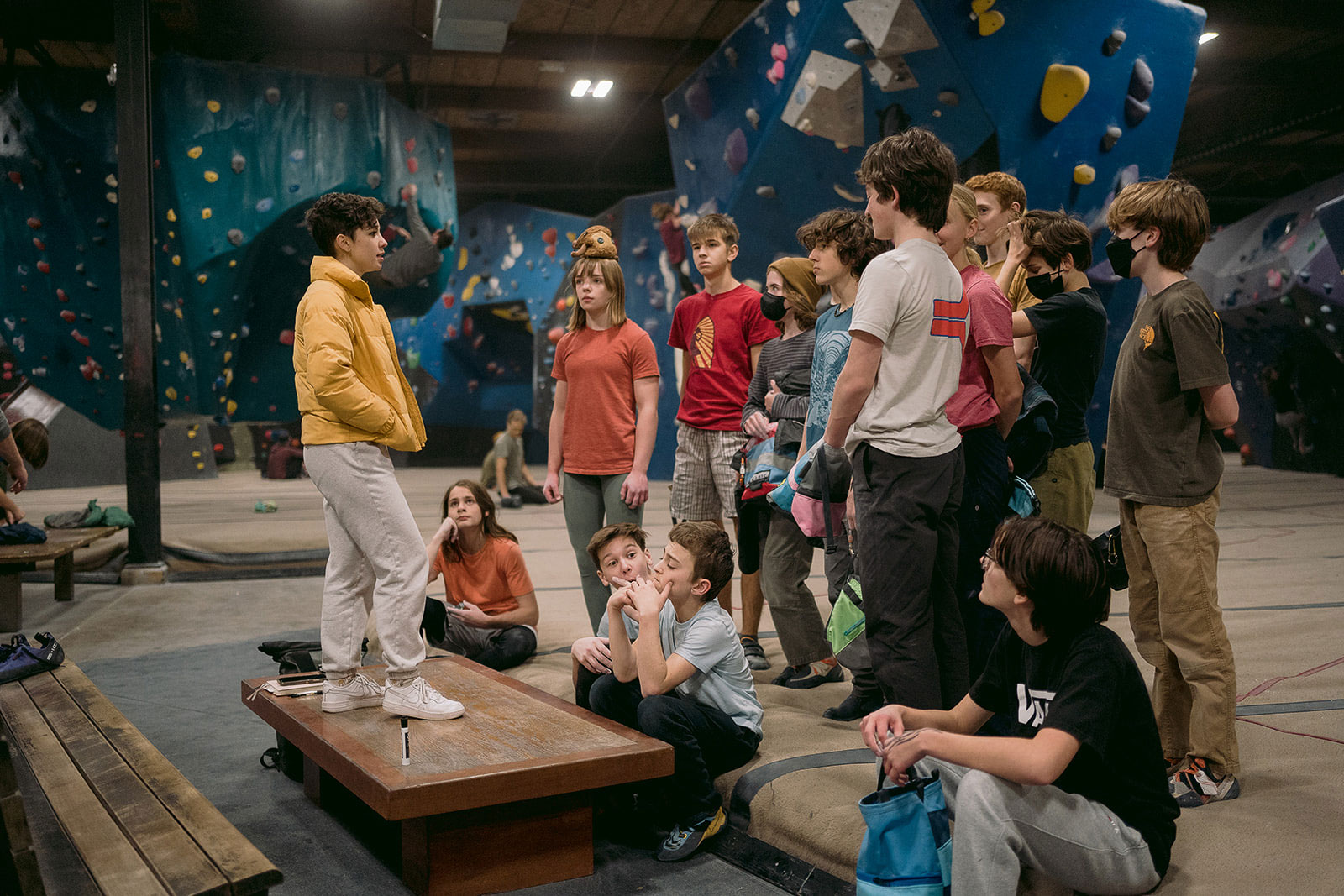
You make an excellent point because, whether that be a setter or a member coming up to you to tell you that this climb was reachy or you boxed somebody out, you’re never going to tell them, like, “Oh, you’re just not strong enough.” You’re never going to say that. You’re going to help them out or maybe even step back and be like, “Is that climb reachy? Maybe I just kind of didn’t think about adding a foot somewhere.” So, awesome point. I’m going to ask a slightly more sad question. What are some less supportive ways that you’ve seen or situations that you’ve encountered, and how can people who fit into the more widely represented size avoid making mistakes like that?
The most common thing that happens is setters being so emotionally attached to what they have created that they are not willing to make those adjustments. Now, I would say that I am pretty fair. As long as I can reach the majority of a set, then I’m good. But if there’s, say I can do all the moves on the nine, but the eight is too reachy, but if they were to change anything, the value or the quality would go down simply for the sake of accessibility. So, I try to be very careful with me saying, “We need another hand there.” But if the hand goes there, it’s going to drop a grade. Or if when you move holds in, then you lose the movement, and the climb isn’t as much fun anymore.
I try to be very aware of what I’m asking of my fellow setters. And for the most part, the people that I work with have been open to those suggestions. When I have experienced setters being too attached to their climbs, it’s when things start to get just a little bit nasty. I have had people say, “I just don’t think that you’re good at this move,” or, “I don’t think that you’re strong enough for this move.” And again, I try to be self-reflective on that, being like, okay, I know what my weaknesses are. I know what my strengths are, and there are times when I say, “Oh, I can’t do this move, but I really think it’s just because I am not good at that move and I just can’t do that,” or, “I’m not strong enough to do this move.” I’m totally comfortable saying that.
Where it can become very unsupportive is when I say, “No, I’m really good at that move.” And the other setter is telling me, “Well, you just can’t do it. I don’t believe that you’re good at this move because you can’t do it.” There needs to be trust on all sides. If the rest of my team is saying, “No, Abby, this is on grade, this move is appropriate for this grade,” I have to trust that, and I also have to be a strong enough leader to be able to say, “No, this move really does need to change.” And to have the rest of my team say, “Alright.” And that can be tricky, because I never want to play that power card in an unhealthy way, and I also want to be trusted. So, it’s all a balance. It’s all a give and take from all sides. So, yes, I have experienced unsupportive times when I’m not listened to, I’m not trusted, and I’m just sort of ignored. But thankfully, I have not experienced that a ton within my setting teams.
For every bad story that I hear in the setting industry, I hear two good ones. So, I’m hoping that if that trend keeps up, it means that we’re moving in a positive and sustainable direction for the industry. And this is still a very young industry. So, fingers crossed, right?
Yes, that is always the hope. Yes.
Yeah. So, let’s talk about the leaders in this industry and with all of the things that you just mentioned about empathy, and I know that you just touched a little bit about leadership and when you should step in and how that line can be really hard to walk. Let’s say if we have a leader who does fit into the widely represented demographic, how can they incorporate some of that to create a supportive environment for all setters, all climbers, whether they be widely represented or underrepresented?
I would say that having a general atmosphere of trust and respect goes a really long way. When people feel respected and trusted, there is some freedom to try new things. There is courage to speak up when something doesn’t feel right or sound right, and communication is positive. So, one of the things that leaders can do is making sure that they’re thanking their setters and their coworkers, making others feel appreciated can go a really long way. Being open to criticism themselves in a way that doesn’t make it sound like they’re taking it personally, which can be hard. I, for example, wear my heart on my sleeve, and when people tell me, they’re like, “Oh, this move isn’t working,” or “This move is bad,” I often am never upset at them. I always am like, “No!” Which is why I’m working on my self-talk. [laughs] It’s almost often directed at myself, that negativity. But if you as a leader can accept criticism in a graceful way, that can also encourage others to do the same.
That’s awesome. That’s some startling self-awareness. I love it. And I think people often just think that there is some magic formula that these excellent leaders are employing. But no, it’s just trust and respect and communicate with your coworkers and your employees. Is it that simple? It is that simple, right?
It is. Yes.
Okay, let’s kind of flip the script for a minute, because we talked about things on the setting job that may be a little harder for someone with a smaller frame to come by. Let’s talk about the opposite. What are some job requirements of a setter that may be easier to come by for a smaller human?
Well, aside from shorter people in the setting world, to be involved in USAC comps?
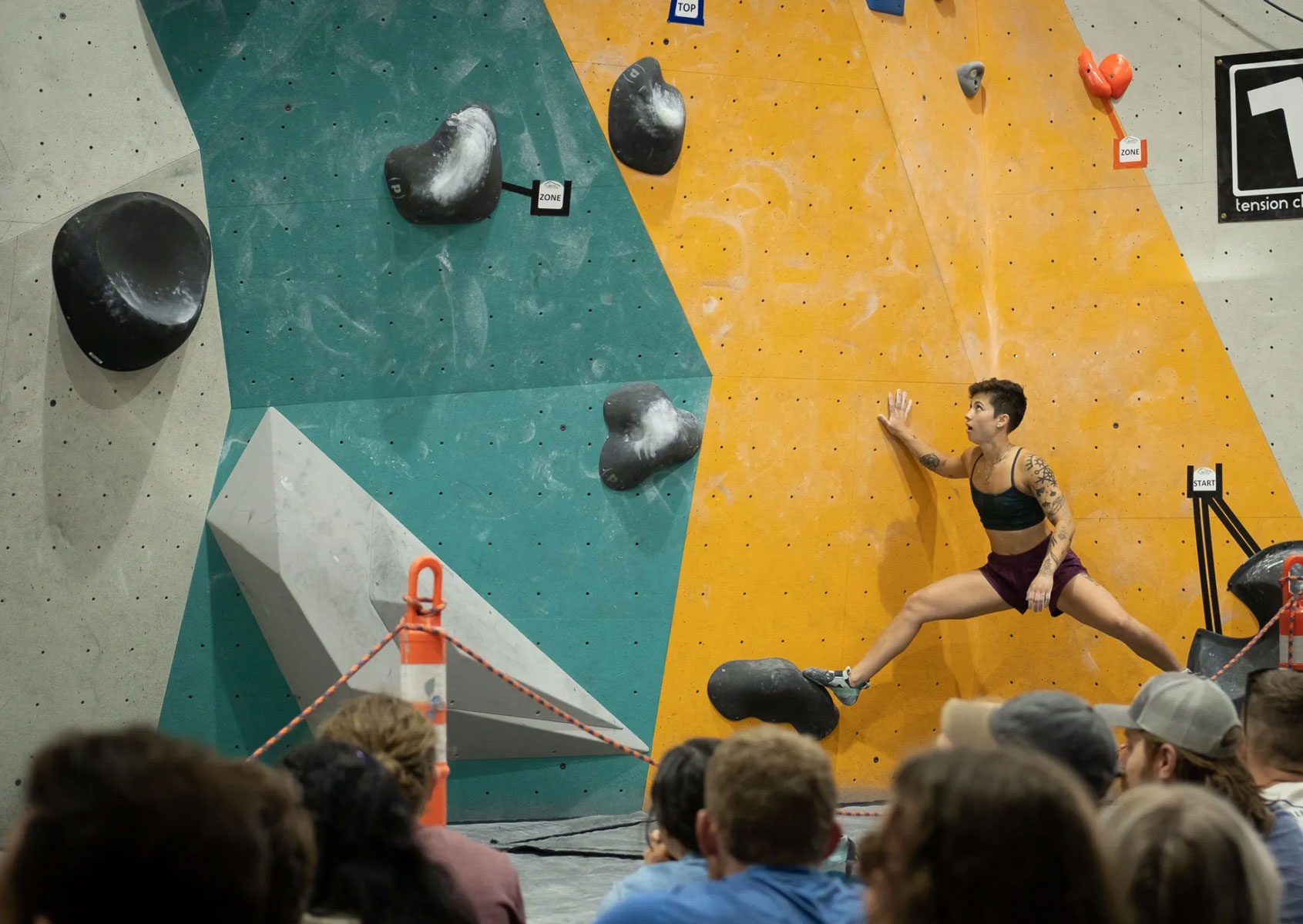
Yes, that’s the standard that people go to: “Oh, we hired this short person because they can do reach checks and set youth comps.” I’m like, “Well, yes, but every competent setter should be able to do a reach check and set a youth comp.”
One of the things that I think shorter people bring to the setting world is just another perspective. While I do think that there is a general consensus about what a V6 should feel like, depending on the rock type. Outside, specifically, who it was who developed that area. In gyms, even in one city, who the setters are, what their owners think about grades, or even what their owners want their members to experience. Grades can differ so dramatically across the sport. And of course, I’ve mentioned before, body type, strengths and weaknesses can affect the feeling of a grade. But one of the things that I think everybody can benefit from is watching as many different body types on the wall as possible.
As a shorter climber, watching a 6’4 climber climb one of my routes is fascinating because that’s not how my brain works. I can guess what a taller climber is going to do on one of my routes, but actually watching the decisions that they make on the wall is fascinating to me, not just as a setter but as a climber. And so I think setters benefit greatly by watching shorter people climb on their routes to understand movement better. So really, we’re doing the industry a service by showing the many different ways that a route can be climbed. It’s so fun. [laughs]
It is. I agree with that. And it goes beyond just like, I mean, you touched on it a little bit, but strength, right. I’ve seen really flexible people who can put their foot above their head and then pull through that and I’m like, “Well, you just broke my beta to bits, but I don’t mind it for a second because that was amazing.”
Yeah. [laughs]
Your perspective is so awesome because my first thought was, “I guess we fit behind walls better?” Which is just a really surface way to look at things. But I’m glad that you have that perspective to share because it is really eye-opening. [laughs] Yeah. So, with all of this about reach and body types, let’s move on because I also want to talk about your setting and your climbing philosophy. I’m wondering, what are some of your favorite styles to set and why? Like, for example, does your strength play into it, or does your body type play into it, or does none of that play into it? I want to know that.
What I have preferred has changed over time. Like I said at the beginning, I was very focused on movement. Movement is for sure, I think, the most important part of climbing, don’t get me wrong. However, in recent years I have been really excited about aesthetics.
Go on.
I am by nature an artist. I have always loved creating things—drawing, painting, all the things. And using plastic holds on the wall to create beautiful shapes is one of my favorite things. And if it just so happens to climb nice, that’s also pretty great. That being said, at least I try not to sacrifice movement for aesthetics. I’m not going to do that, but I really like creating a visually appealing climb. Aside from that, I love a good flow. I love being able to put handholds and footholds exactly where your body wants them to go. So, if you get on the wall and you go up left hand, you’re like, “Oh, I have a perfect foot placement to go gaston over here. Oh, and I have another perfect foot placement to match and lie back.” I love that feeling of your body just knowing exactly what to do on the wall. So, that’s probably one of my favorite types of route to set. But I also love a good wrestle. Do you know what I’m talking about? You put a big ol’ macro on the wall and you got to find a good spot on it and you got to wrestle with it a little bit to work your way up or move your body over or anything. Totally different, but also one of my other favorite things to set.
That’s awesome, because there’s such opposite ends of the spectrum in terms of movement. One is like, “Oh, they look like a ballerina on the wall. They look amazing.” And the other one’s like, “They look like a beached whale, but they’re doing it and it’s amazing.” [laughs] That is a very interesting perspective. I think most setters, myself included, prefer to set within their strength. And you have just like this wide spectrum. And I kind of aspire to be like that at this point. I’m going to try to set a wrestle tomorrow. No, I’m kidding.
It’s one of the things that makes rock climbing and setting so much fun, just the wide spectrum.
Absolutely. I agree. And yeah, it goes back to what you said about different body types in the wall. Like, every body type is going to do each of these moves differently. And the more you watch them, the more you’re going to understand the basics and the physics of rock climbing movement, or even just decision-making. Some people would rather crimp the foot chip over making that long move.
Absolutely.
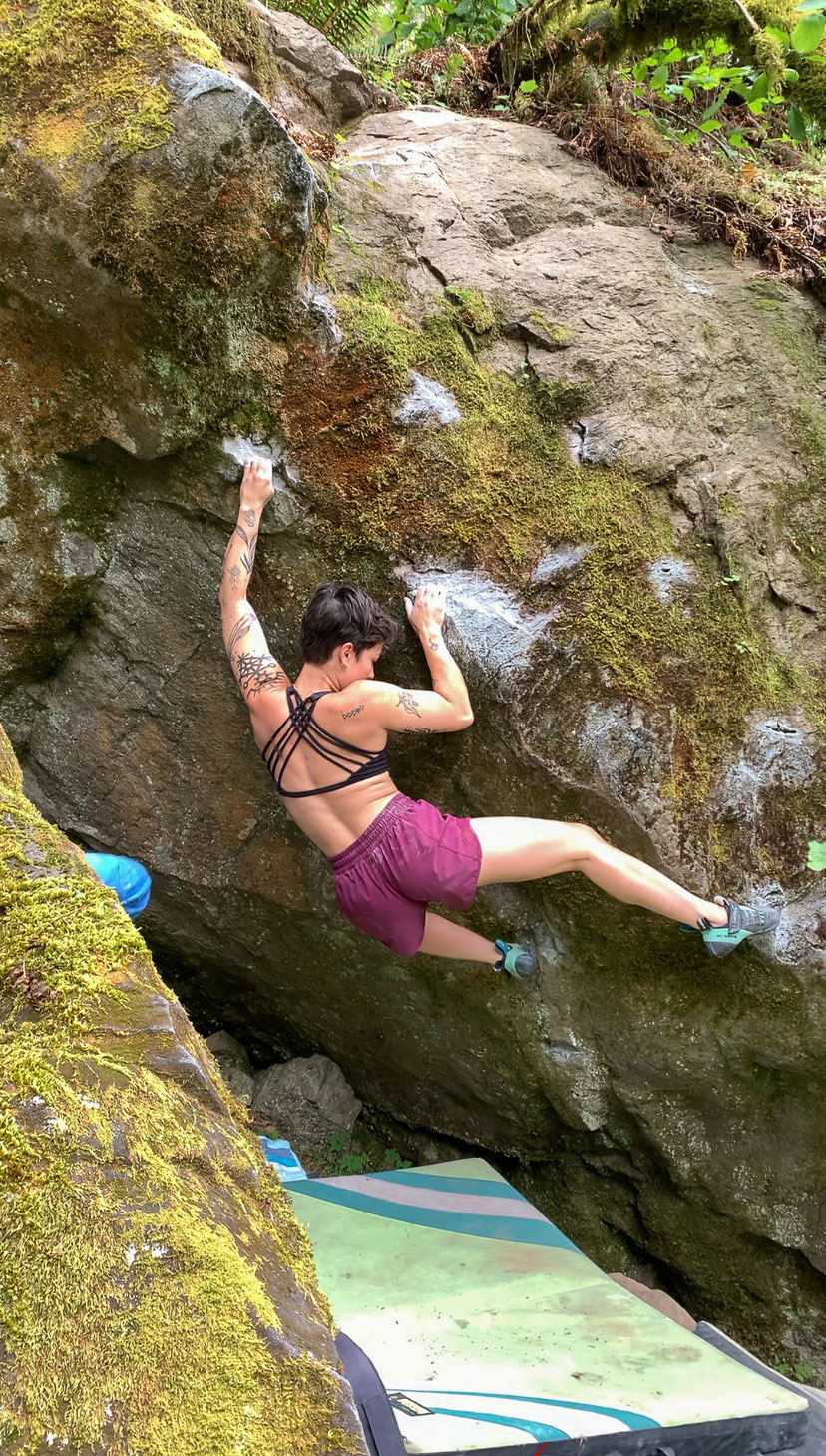
What about what kind of climbing style do you excel at and why?
This has also changed over time. Right now, in my life, I love a good techy climb. One of the reasons I fell in love with rock climbing is probably the same as most other people: the problem-solving. So, while I do love a good flow, there’s something about figuring out the sequencing, figuring out where I need to keep tension in my body, figuring out how much effort I need to put into each move. I love the “ticky-tacky, figuring outings” of a route. It’s one of my favorite things. The team over at Movement in Portland actually does an excellent job at this. I go over there anytime I really want to use my brain. I love a techy climb.
I love that, because the two questions I just asked you, I’m hoping to set up context for the next question, which is one of the things that I really want to tackle with grades and varying body sizes. Because you touched on this before, people of different body sizes or types or strength are going to experience grades differently. So for you, in your opinion, the grade spectrum, how accurate does that feel for you inside, outside? How often do you think a V6 is a V6 and a V10 is a V10?
Grades are such a tricky subject for me, exactly for the reasons that we talked about. I do think that the climbing world has done a pretty good job at figuring out what a true V6 feels like. But even still, depending on what the problem is, it still may feel way harder to me, way easier to me, even, sometimes. I’m very comfortable and confident on tiny little crimps. But as soon as my hands need to go around a pinch where my hand physically cannot reach around the pinch, it’s a V12, I can’t hold onto it. So, depending on that, I don’t know, grades can just, sometimes they just don’t make any sense.
The tallest person on my team is 6’3 with a 6’6 wingspan. And I, of course, am in the total opposite end. He can set a V1 that he just reaches, and he’s like, “Oh yeah, this is a V1.” And I’m over here jumping with all of my might. But all of his 6-plus-foot friends are saying, “Oh yeah, this is a V1.” And everybody under 5’5 is saying, “Ah, this feels like a three or a four.” Again, across gyms, across the world, it’s all going to be convoluted. So, while I think that grades can be a good way to measure progress, it’s not the only way to measure progress. And so, the only way that I can mentally handle grades when setting for them is in my own gym, or at least in a gym where I know what the other grades feel like. So, say I’m setting a three in my gym. I’m like, “Okay, well, at least I have it to compare to the other threes in the gym.” Like a Circuit three is not going to feel like a PRG three. But if I go to PRG and I set over there, I will set a three like they will set a three. Like, I’m going to take that into account wherever I end up setting. So, that is how little I think of grades.
I kind of like your approach to it because it does not put your self-worth in grades. And going back to, yeah, it does not. And like you said, we should use grades to measure progress to an extent. But just because you don’t climb a V10 does not make you any less of a wonderful human being.
No.
So, for anyone out there who’s listening and you think that climbing V10 will solve all your problems, it might solve some of them, but definitely not all.
Right, not even your self-worth as a climber, but even your progress as a climber. I’ve had to tell multiple clients—I do private lessons as well—I’ve had to tell multiple clients that just because they climbed three sixes last week and they can’t climb this one six, they get so fixated on the grade and what they think they should be able to climb. And that’s just, they’re going to continually be disappointed if they keep that mindset.
Yes, exactly. And what you mentioned earlier about grades and climbing gyms and how each gym has their own V3, that was one of the first things that I learned as a guest setter. When I went to a gym, sometimes I’d arrive a little early or come a day before and try the climbs in their gym to be like, “Okay, this is what a V3 is in their gym. This is what a V6 is in their gym.” Like, if I take my definition of a V6 from Colorado and I went to Arizona and set it there, it might be too easy, it might be too hard, and it’s kind of going to make you look like a bad guest setter.
Yeah.
So that’s a great point to bring up. And you touched on the feelings of self-worth a little bit, because that kind of segues into the next question that I want to ask you, is that when grades don’t feel accurate for you—like you said, this three V6 feel great for the client, and the next week they can’t climb this V6—the feelings are understandably going to feel negative. And we tackled this a little bit earlier in this episode where you talked about impostor syndrome. But when those feelings are negative, how do you, as a setter, as a climber, handle it with an optimistic or even just a neutral outlook?
Because of the position that I’m in—I’m the Assistant Headsetter at my gym—because of this position, there is a part of my responsibility that falls under having the final say. So this does put a decent amount of pressure on me, from myself, from my team. But I do think that it still has to come back to trust in the opinion of my team as well. So, I do have gut feelings to situations. So, if I feel like, “Man, that three does feel harder than any other three in the gym.” And if a climb feels harder than the intended grade, I do have a negative feeling towards that because my three climbers are going to come in and be like, “I can’t climb this three. That’s crazy because I can climb the other threes.” Because we want our clientele to have fun and to have a good experience. And most people, when their expectations are not met, they’re no longer having fun, which is unfortunate. You would hope as a setter that they would look at this climb and say, “What a fun challenge.” But not everybody has that open mindset. Most people have very closed mindsets in regards to challenges and how it affects their personal growth. So, my attitude is typically negative at first, especially in the moderate and lower grades. I feel this guilt and almost feel a little bit protective over our clientele.
Understandably.
So, yeah, that’s usually a negative feeling. But also, on the other end, say we featherbag an eight, then I’m thinking, “Oh, I’m worried that this eight is too easy. Our eight climbers are going to be so disappointed. They’re going to flash it and be like, ‘Well, that wasn’t very fun. I didn’t have to try very hard or I got it in like two goes, whatever.’” What I’ve been trying to do more of, I’ve been trying to look at the featherbagging as, “This is going to be someone’s first eight and they’re going to be so excited that they got their first eight.” Sometimes that has to be in my mindset in order for me to get through the process of grading.
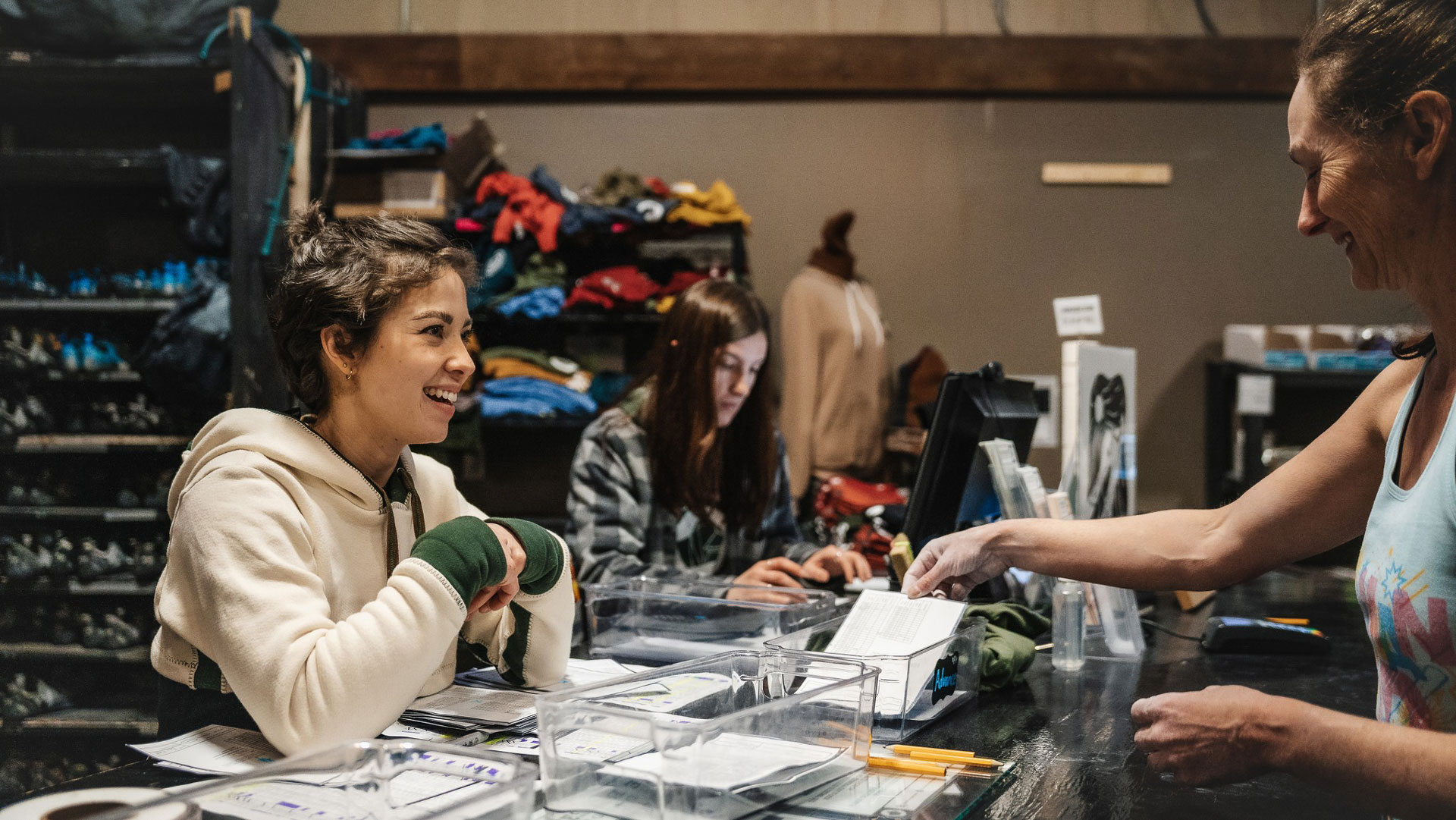
One thing that I took away from that is the word featherbag. That, am I just, like, not cool anymore, and I don’t know the cool, hip terminology? Why have I never heard of that before? But at the same time, it makes so much sense. Featherbag, opposite of sandbag, right?
Yes. Well, let me be very clear. You are very cool, Holly. [laughs] Yes. Featherbagging is the opposite of sandbagging. So, we don’t want to sandbag people in our gyms. And the reason I say that is because, again, we want our clients to have a fun time. And if they’re falling off of everything, it’s no longer a fun time. But also, we don’t want a featherbag because the same results can happen. One of the reasons people love climbing is the figuring out the puzzle, the being challenged. If everything is too easy and they’re just flashing everything, who knows? Maybe people enjoy that. I’m sure people enjoy that. Ultimately, grades are important, even though they can be silly. But it all comes down, especially in the commercial setting world, consistency, I guess. And that’s very hard to achieve. And so, when there is not consistency, especially from a leadership perspective, that can be kind of frustrating. And for the rest of the set team, confusing. And for the clientele, confusing.
In addition to the consistency, the occasional featherbag or the sandbag must be balanced out.
Yes.
Okay. Those are solid advice that I will take, and the rest of the climbing world will take as well. I say this a lot, but I genuinely mean it when I say it, but I could talk to you all night. But I want to be respectful of your time and we are coming to an end of the podcast. I want to end on a fun note. Abby, what is something that you are really looking forward to in the coming year, in 2024?
Well, in February, I am finally leaving my 20s. I’m hitting that dirty 30, and I’m leaving my 20s with a bang. I’m going to take myself on vacation, and it’s going to be a great time.
That’s awesome. Where are you going for vacation?
Hopefully Hawaii.
That sounds amazing. Abby, you’re going to have so much fun there, whether it be climbing or surfing or, you know, becoming a potato on a beach, all of them sound awesome. [laughs] Thank you so much for joining me tonight, Abby. This has been an awesome conversation. I hope I get to sling some plastic with you again soon.
That would be awesome. It’s been my pleasure. Thank you for having me.
A big thank you to Abby Tran for taking the time to share her thoughts and insights. The Impact Driver podcast is a production of the Climbing Business Journal. I’m your host, Holly Chen. Today’s episode is sponsored by Essential Climbing and Strati Climbing. It was edited and produced by myself, Scott Rennak, and the team at CBJ. Our theme music is by Devin Dabney. The transcript and web content is edited by Naomi Stevens. Special thanks to Gaby Eck, Sarah Kirkpatrick, and Hope Rose. That’s it, folks. Thank you for listening to today’s episode with Abby. Check us out next time. If you enjoy what you heard, give us a shout on social media and subscribe to CBJ at climbingbusinessjournal.com.

Holly grew up in Taiwan and Hong Kong. Now she lives in Denver where she reports, writes and routesets. Beyond the Climbing Business Journal, her writing has been published by Alpinist Magazine, Climbing Magazine, Gym Climber and Sharp End Publishing. Holly’s motto has always been: “keep it interesting.”
Read our interview with Holly: Storytelling Through Movement




